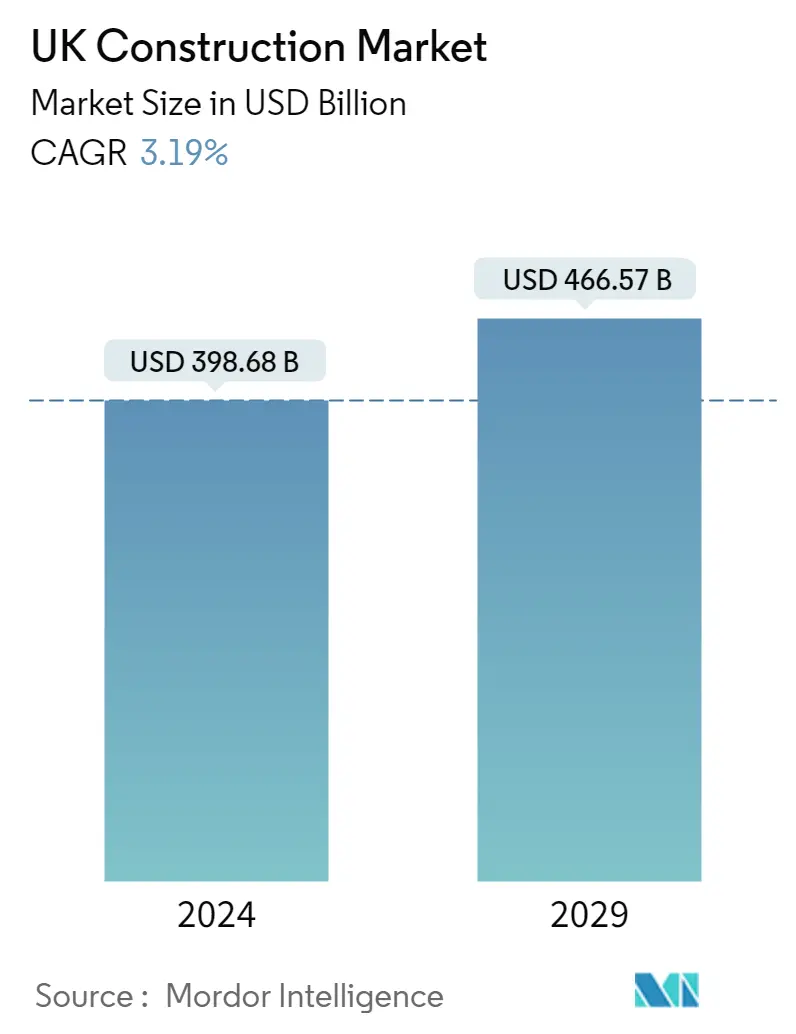Market Size of UK Construction Industry

| Study Period | 2020 - 2029 |
| Base Year For Estimation | 2023 |
| Market Size (2024) | USD 398.68 Billion |
| Market Size (2029) | USD 466.57 Billion |
| CAGR (2024 - 2029) | 3.19 % |
| Market Concentration | Medium |
Major Players
*Disclaimer: Major Players sorted in no particular order |
UK Construction Market Analysis
The UK Construction Market size is estimated at USD 398.68 billion in 2024, and is expected to reach USD 466.57 billion by 2029, growing at a CAGR of 3.19% during the forecast period (2024-2029).
The increasing building activities in the country drive the market. Furthermore, the market is driven by the growing commercial activities in the country.
- Due to the strict execution of the measures to restrict the disease's spread, the COVID-19 pandemic negatively impacted the UK construction industry in 2020, with overall output decreasing by almost 46% year over year in April 2020. However, there has also been a significant recovery, with positive growth rates in the UK's construction output every month since March 2021. The gross value added by building activities in the UK returned to pre-pandemic levels in the third quarter of 2021 and continued to increase. For instance, compared to 2020, more new homes were registered to be built in 2021 in every region outside London, with growth rates in the North East, East Midlands, and Eastern regions reaching above 45%. Infrastructure construction had the biggest market share growth in the sector.
- Even though the general trends point to significant expansion, the UK construction industry has recently faced numerous difficulties. Inflation and Russia's invasion of Ukraine further disrupted the supply chain and drove up the price of building materials, in addition to the COVID-19 outbreak. For instance, rising energy and oil prices impacted steel production, which requires a lot of energy. Concrete reinforcing bars, also composed of steel, cost 45.8% more in March 2022 than in March 2021. The cost of transporting other construction supplies has increased due to the rising price of oil, driving up the overall cost of most construction materials.
- At the start of 2021, the value of new warehouse construction orders rose significantly, reaching a peak. In the second quarter of 2022, warehouse construction orders were worth 1.4 billion British pounds. The value of new construction orders for public buildings in the health sector in Great Britain amounted to 561 million British pounds in the second quarter of 2022. In the first half of 2022, roads and railways were the infrastructure types with the highest output value in Great Britain. On the other side of the spectrum, water and sewerage construction had the lowest output values, under 165 million British pounds in 2022, according data from the to Office for National Statistics (United Kingdata.
UK Construction Industry Segmentation
Construction is the installation, maintenance, and repair of buildings and other stationary structures, as well as the construction of roadways and service facilities that form fundamental components of structures and are required for their operation. Construction encompasses the processes involved in constructing buildings, infrastructure, industrial facilities, and related operations from start to finish. A complete background analysis of the United Kingdom Construction Market, including the assessment of the economy and contribution of sectors in the economy, a market overview, market size estimation for critical segments, emerging trends in the market segments, market dynamics and geographical trends, and COVID-19 impact, is covered in the report.
The United Kingdom construction market is segmented by sector (commercial construction, residential construction, industrial construction, infrastructure construction, and energy and utility construction) and key regions (England, Northern Ireland, Scotland, and Wales). The report offers market size and forecasts in value (USD) for all the above segments.
| By Sector | |
| Residential | |
| Commercial | |
| Industrial | |
| Infrastruture | |
| Energy and Utilities |
| By Key Regions | |
| England | |
| Northern Ireland | |
| Scotland | |
| Wales |
UK Construction Market Size Summary
The UK construction industry is poised for growth, driven by increasing building activities and expanding commercial ventures. Despite the challenges posed by the COVID-19 pandemic, which initially led to a significant decline in construction output, the sector has shown resilience and recovery, returning to pre-pandemic levels by late 2021. The industry benefits from the UK's strong competitive edge in architecture, design, and engineering, with British firms leading in sustainable construction solutions. Government initiatives aimed at economic recovery, such as reforms in the planning system and funding for infrastructure projects, are expected to further stimulate the market. The private housing sector remains a significant contributor to the industry's output, with ongoing growth anticipated in the coming years.
The construction market in the UK is characterized by a mix of regional, local, and a few global players, with major companies like Kier Group plc, Morgan Sindall Group plc, and Mace Ltd playing pivotal roles. The sector's growth is supported by increased construction investments and major upcoming projects, particularly in residential and transport construction. The market's partial fragmentation presents opportunities for expansion, especially as the government announces substantial capital investments in transport infrastructure. These developments, coupled with strategic acquisitions like The Access Group's purchase of Construction Industry Solutions, are set to enhance the industry's capacity and drive further growth during the forecast period.
UK Construction Market Size - Table of Contents
-
1. MARKET DYNAMICS
-
1.1 Market Overview
-
1.2 Drivers
-
1.2.1 Transport Infrstructure Investment
-
-
1.3 Restraints
-
1.3.1 Shortage of Skilled Labor
-
-
1.4 Opportunities
-
1.4.1 The Birmingham Big City Plan
-
-
1.5 Value Chain / Supply Chain Analysis
-
1.6 Industry Attractiveness - Porter's Five Forces Analysis
-
1.6.1 Bargaining Power of Suppliers
-
1.6.2 Bargaining Power of Buyers/Consumers
-
1.6.3 Threat of New Entrants
-
1.6.4 Threat of Substitute Products
-
1.6.5 Intensity of Competitive Rivalry
-
-
-
2. MARKET SEGMENTATION
-
2.1 By Sector
-
2.1.1 Residential
-
2.1.2 Commercial
-
2.1.3 Industrial
-
2.1.4 Infrastruture
-
2.1.5 Energy and Utilities
-
-
2.2 By Key Regions
-
2.2.1 England
-
2.2.2 Northern Ireland
-
2.2.3 Scotland
-
2.2.4 Wales
-
-
UK Construction Market Size FAQs
How big is the UK Construction Market?
The UK Construction Market size is expected to reach USD 398.68 billion in 2024 and grow at a CAGR of 3.19% to reach USD 466.57 billion by 2029.
What is the current UK Construction Market size?
In 2024, the UK Construction Market size is expected to reach USD 398.68 billion.

